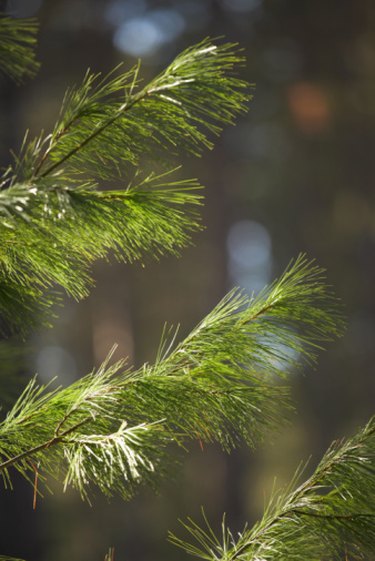
Needle infections can cause yellowing of pine needles, as well as needle drop, which decreases the value of the tree. While most conifers are at risk for developing needle infections and diseases, Scots pines are most likely to suffer from severe forms of the disease. Severe cases of discoloration and defoliation of pine needles may result in poor tree health.
Lophodermium Needle Cast
Video of the Day
Lophodermium needle cast is caused by the fungus known as Lophodermium seditiosum. Pine needles on the Austrian, red, Scots and Virginia pines sustain the most damage from this disease. Affected pine tree needles develop brown spots on the needles with yellow halos in the late fall. By early spring, the spots are larger and more obvious, eventually turning the pine needle yellow. Pine needles then turn brown and shed through the summer, with only small patches of green current-season needles left by late summer. Fungal spores are spread by the wind and infect pine needles during moist weather from August to October. Cool moist weather in late summer and early fall often leads to destructive outbreaks of this needle cast disease.
Video of the Day
Naemacyclus Needle Cast
Naemacyclus needle cast primarily affects Scots pines, the common Christmas tree. Austrian, Virginia, mugo and eastern white pines are also susceptible to this needle cast disease. The fungus Cyclaneusma minus causes Naemacyclus needle cast symptoms to appear the year after the tree is infected. Beginning in the late summer and fall, green spots appear on needles in their second and third year. Affected pine needles turn yellow, then brown and drop from the tree. Yellowing of pine needles prematurely decreases the value of the pine tree, according to the University of Kentucky.
Pine Wilt
Yellowing of pine needles is often caused by pine wilt, states the University of Illinois Extension. Pine wilt is caused by the pine wood nematode, which is carried from one tree to another by insects. Most susceptible to this condition is the Scots pine, and the eastern pine is the most resistant to pine wilt. Pine trees infected with pine wilt have pine needles that fade to yellow or light green and the tree becomes stunted. Pine trees infected with pine wilt in the spring often die by late summer and early fall.